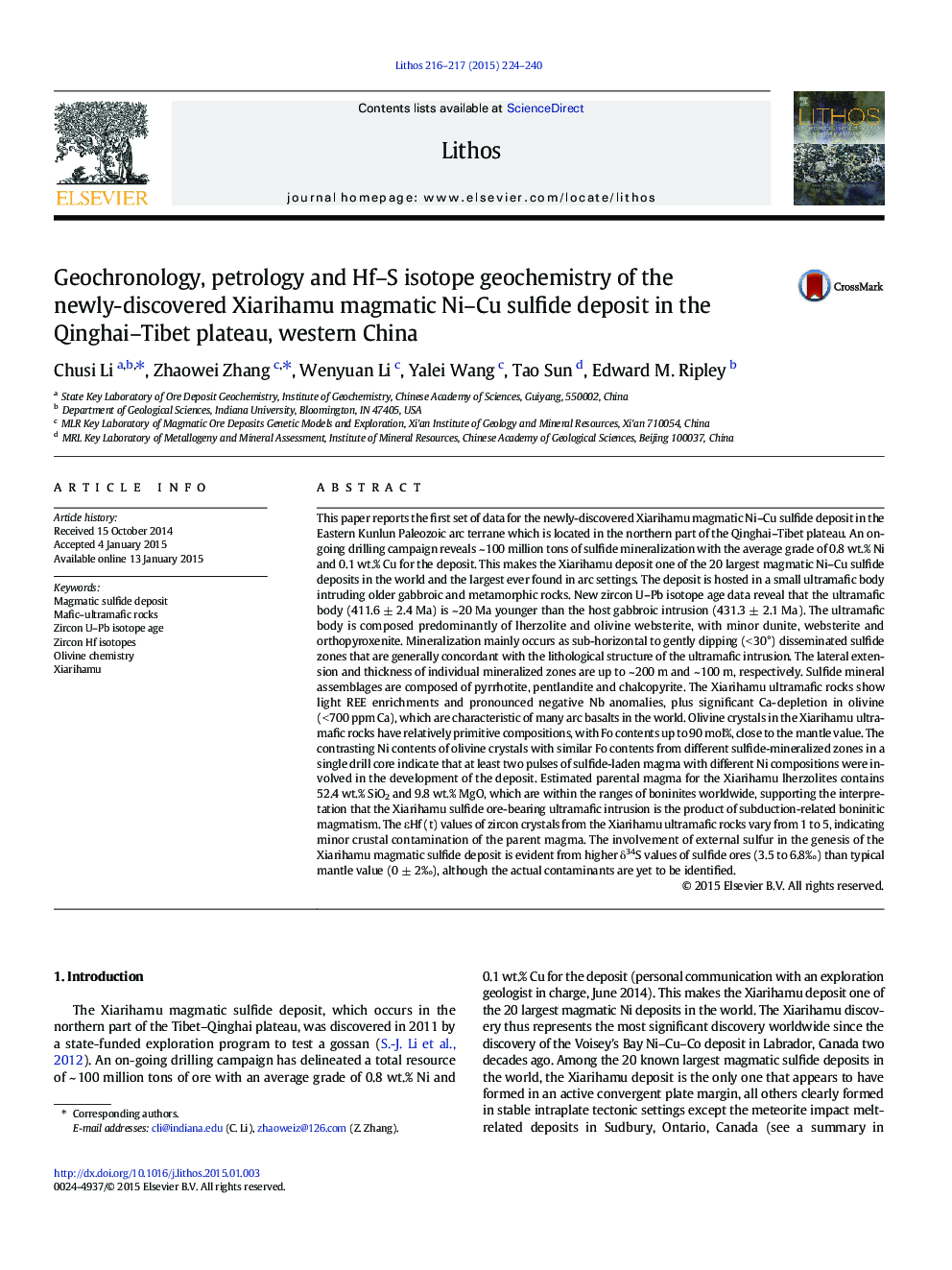| کد مقاله | کد نشریه | سال انتشار | مقاله انگلیسی | نسخه تمام متن |
|---|---|---|---|---|
| 6440773 | 1638668 | 2015 | 17 صفحه PDF | دانلود رایگان |
عنوان انگلیسی مقاله ISI
Geochronology, petrology and Hf-S isotope geochemistry of the newly-discovered Xiarihamu magmatic Ni-Cu sulfide deposit in the Qinghai-Tibet plateau, western China
دانلود مقاله + سفارش ترجمه
دانلود مقاله ISI انگلیسی
رایگان برای ایرانیان
موضوعات مرتبط
مهندسی و علوم پایه
علوم زمین و سیارات
ژئوشیمی و پترولوژی
پیش نمایش صفحه اول مقاله

چکیده انگلیسی
This paper reports the first set of data for the newly-discovered Xiarihamu magmatic Ni-Cu sulfide deposit in the Eastern Kunlun Paleozoic arc terrane which is located in the northern part of the Qinghai-Tibet plateau. An on-going drilling campaign reveals ~ 100 million tons of sulfide mineralization with the average grade of 0.8 wt.% Ni and 0.1 wt.% Cu for the deposit. This makes the Xiarihamu deposit one of the 20 largest magmatic Ni-Cu sulfide deposits in the world and the largest ever found in arc settings. The deposit is hosted in a small ultramafic body intruding older gabbroic and metamorphic rocks. New zircon U-Pb isotope age data reveal that the ultramafic body (411.6 ± 2.4 Ma) is ~ 20 Ma younger than the host gabbroic intrusion (431.3 ± 2.1 Ma). The ultramafic body is composed predominantly of lherzolite and olivine websterite, with minor dunite, websterite and orthopyroxenite. Mineralization mainly occurs as sub-horizontal to gently dipping (< 30°) disseminated sulfide zones that are generally concordant with the lithological structure of the ultramafic intrusion. The lateral extension and thickness of individual mineralized zones are up to ~ 200 m and ~ 100 m, respectively. Sulfide mineral assemblages are composed of pyrrhotite, pentlandite and chalcopyrite. The Xiarihamu ultramafic rocks show light REE enrichments and pronounced negative Nb anomalies, plus significant Ca-depletion in olivine (< 700 ppm Ca), which are characteristic of many arc basalts in the world. Olivine crystals in the Xiarihamu ultramafic rocks have relatively primitive compositions, with Fo contents up to 90 mol%, close to the mantle value. The contrasting Ni contents of olivine crystals with similar Fo contents from different sulfide-mineralized zones in a single drill core indicate that at least two pulses of sulfide-laden magma with different Ni compositions were involved in the development of the deposit. Estimated parental magma for the Xiarihamu lherzolites contains 52.4 wt.% SiO2 and 9.8 wt.% MgO, which are within the ranges of boninites worldwide, supporting the interpretation that the Xiarihamu sulfide ore-bearing ultramafic intrusion is the product of subduction-related boninitic magmatism. The εHf (t) values of zircon crystals from the Xiarihamu ultramafic rocks vary from 1 to 5, indicating minor crustal contamination of the parent magma. The involvement of external sulfur in the genesis of the Xiarihamu magmatic sulfide deposit is evident from higher δ34S values of sulfide ores (3.5 to 6.8â°) than typical mantle value (0 ± 2â°), although the actual contaminants are yet to be identified.
ناشر
Database: Elsevier - ScienceDirect (ساینس دایرکت)
Journal: Lithos - Volumes 216â217, February 2015, Pages 224-240
Journal: Lithos - Volumes 216â217, February 2015, Pages 224-240
نویسندگان
Chusi Li, Zhaowei Zhang, Wenyuan Li, Yalei Wang, Tao Sun, Edward M. Ripley,